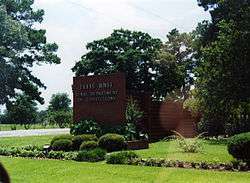Shaka Sankofa
Shaka Sankofa (born Gary Lee Graham; September 5, 1963[1] – June 22, 2000) was a Texas death-row inmate who was sentenced to death at the age of 17 for the murder of 53-year-old Bobby Grant Lambert in Houston, Texas, on May 13, 1981. He was executed by lethal injection on June 22, 2000 in Huntsville, Texas.[2]
Shaka Sankofa | |
|---|---|
| Born | Gary Lee Graham September 5, 1963 |
| Died | June 22, 2000 (aged 36) |
| Criminal status | Executed |
| Children | 2 |
| Conviction(s) | Murder |
| Criminal penalty | Death by lethal injection |
Lambert's murder occurred at night in the parking lot of a Safeway supermarket. Although Sankofa denied committing the murder, he admitted that at the time of Lambert's death he was on a week-long spree of armed robberies, assaults, attempted murders and one rape. He was captured after a 57-year-old woman he had kidnapped, raped and tortured gained control of his gun and held it on him. She then called police.
Sankofa maintained his innocence of Lambert's murder from the time of his arrest and throughout the nineteen years he spent on death row. He pleaded guilty to armed robbery charges.
Sankofa's supporters, including Coretta Scott King, bishop Desmond Tutu, Al Sharpton, Jesse Jackson, and celebrities Danny Glover, Kenny Rogers, Lionel Richie, Harry Belafonte and Ruby Dee, brought his case international attention, arguing that his conviction was based on the claim that the testimony of a single eyewitness who said she saw him for a few seconds in the dark parking lot committing the murder.[3] The witness contradicts this claim, stating she saw his face three times over the course of two to three minutes as she followed him from the crime scene. She was one of 19 witnesses to identify Graham during a crime spree which included 20 armed robberies, 3 kidnappings, 1 rape, and 3 attempted murders in addition to the Lambert murder.
The jury did not hear testimony from a few other apparent eyewitnesses who believed that Sankofa was not the killer because they believed he was too short to be the killer. They did not see his face. No other suspects were questioned and there was a lack of physical evidence. Supporters also argued that there was other crucial evidence the jury did not hear and that he had poor legal representation at the time of his trial.
At the time of his execution, Sankofa became the 23rd inmate executed in Texas during 2000 and the 222nd person to be executed in Texas since capital punishment was resumed there in 1982.[4]
Childhood
Gary Lee Graham was born to Thelma Griffin and Willie Graham. A high school dropout, Sankofa was illiterate at the time of his arrest. Growing out of control as a teen, his negative behavior began with nonviolent petty offenses, starting on May 14, 1981. On May 20, he was arrested for his first major felony: the series of ten armed robberies and aggravated assaults during his week-long spree of crime, including the rape of 57-year-old taxi driver Lisa Blackburn, which he pleaded guilty to and faced 20-year prison sentences. On May 27, however, witness Bernadine Skillern identified Sankofa as Lambert's murderer, and on November 9, at age 18, Sankofa was on death row for the murder of Lambert.
Prison



Sankofa entered the Texas Department of Criminal Justice (TDCJ) as inmate #696 on November 9, 1981.[1] Sankofa was initially located in the Ellis Unit, but was transferred to the Allan B. Polunsky Unit (formerly the Terrell Unit) in 1999.[5]
In prison, Sankofa learned to read and write, earning his GED and paralegal certification. From the day of his arrest, he acknowledged portions of his week-long crime spree. For these crimes, he had served almost two decades in prison, apologizing verbally and in writing to the victims of these crimes and asked young people to turn their backs on criminal conduct.[6]
Graham's mother was found dead on the street in 1988. However, until their deaths, Graham's parents were fiercely sure of his innocence and spent their last years struggling to free him from death row.[7]
He became a political activist and in 1995 changed his name from Gary Lee Graham to Shaka Sankofa. The name "Shaka" was chosen in honor of the great South African warrior Shaka Zulu, and "Sankofa" means to go back to the past and bring to the present, according to Rev. Herbert Daughtry of New York; the name also "represented linking the current struggle against capital punishment with the historical struggle Blacks have waged for freedom, justice and equality." He also co-founded a prison organization and newspaper, The Endeavor Project, which were devoted to abolishing the death penalty. By the end of his life, he had also written a soon-to-be-published book, The Evolution of Shaka Sankofa. [8]
Sankofa was scheduled to be executed five times: once in 1987, three times in 1993 (April, in which Lambert's widow Loretta appealed to Governor Ann Richards to spare Sankofa's life; May and August), and once on January 11, 1999, and each time he was given a stay of execution before it was lifted.[7]
Execution
Sankofa was put to death following a series of last-minute legal maneuvers, including an appeal to the U.S. Supreme Court, which declined to halt the execution in a 5-4 vote. Sankofa's attorneys then filed a civil suit in federal court in Austin, Texas, charging the execution was a violation of his civil rights. District Court Judge James Nowlin rejected that claim.
There was heavy security outside the Huntsville Unit, known as "The Walls", with riot police equipped with tear gas and batons. Thousands of protesters showed up outside the prison on the night of Sankofa's execution. Anti-death penalty advocates marched, waved signs and chanted, "Let Gary Graham live!" Prison authorities took no chances, corralling Sankofa's opponents and supporters on separate ends of the imposing brick prison. At one point, about a hundred Sankofa supporters attempted to confront around twenty Ku Klux Klansmen demonstrating in favor of the execution, but the police kept them apart. Two protesters who tried to break through police barricades were tackled by officers, who handcuffed them and took them away.[9]
After the appeals had failed, Sankofa resisted when the time came for him to be taken to the death chamber. A Cell Extraction Team was dispatched to force him towards the death chamber, where it took five jail guards to strap him to the gurney.[10]
Witnesses to the execution on the victim's behalf included Bobby Hanners, Lambert's grandson; Diane Clements, a family friend and director of the victims' rights group, Justice for All; and Rick Sanford, one of Graham's victims during his rampage. "My heart goes out to the Graham family as they begin the grieving process," Hanners said in a written statement. "I also pray Gary Graham made peace with God. But I truly believe justice has been served."[9]
Witnesses to the execution on Sankofa's behalf included his stepmother Elnora Graham, his spiritual advisor, Nation of Islam Minister Robert Muhammad, Bianca Jagger, Rev. Jesse Jackson and Rev. Al Sharpton.
Sankofa released a final statement in which he again asserted his innocence and denounced the government.[11]
Funeral and memorial service
More than 2000 people attended Sankofa's wake on June 28, 2000 and his funeral the following day. He was buried at Paradise North Cemetery in Houston in a gold-colored casket, wearing a turquoise and gold African garment.[8] Ross Mortuary in Houston's 5th Ward had his body.
Family
Sankofa was survived by his daughter and son, Deidra and Gary Lee Hawkins, ages 19 and 20, respectively, at the time of their father's execution. He was also survived by his granddaughter, stepmother, paternal grandmother, sister, stepsister, and three brothers.
His son Gary, who was two years old at the time of his father's arrest, was arrested at the age of 20 for the murder of his friend, 32-year-old Melvin Pope, on March 28, 2000, about three months before his father's execution. On March 27, 2001, he was convicted of the murder and sentenced to life in prison. He maintains his innocence.[12]
See also
- Thompson v Oklahoma
- Roper v Simmons
- List of people executed in Texas, 2000–09
- List of juvenile offenders executed in the United States
- Capital punishment in the United States
References
- "Graham, Gary." Texas Department of Criminal Justice. Retrieved on July 17, 2016.
- "Fight the Death Penalty in the USA: Executions in 2000". Retrieved 2009-01-23.
- CNN.com (2000-06-09). "Burden of Proof - Texas Death Row Case: Gary Graham Scheduled to be Executed in Less Than Two Weeks". Retrieved 2007-12-17.
- "Texas parole board considers fate of condemned man". CNN. June 22, 2000. Retrieved 2009-01-23.
- "Death Row Facts." Texas Department of Criminal Justice. Retrieved on February 4, 2016.
- "Gary Graham - A Child On Death Row, A Tragedy Unfolding". Retrieved 2009-01-23.
- "Stop The Execution Of Gary Graham !". Retrieved 2009-01-23.
- Muhammad, Stacey (2000-07-11). "Memorial services salute Shaka Sankofa, the fight against the death penalty". The Final Call. Retrieved 2009-01-23.
- CNN.com (2000-06-23). "Texas executes Graham for 1981 murder despite his pleas of innocence". Archived from the original on 2007-03-12. Retrieved 2007-12-17.
- "Texas Executes Shaka Sankofa (Gary Graham)". Democracy Now!. June 23, 2000. Retrieved 2009-01-23.
- "Last Statement - Gary Graham". Archived from the original on 2009-01-07. Retrieved 2009-01-23.
- Rubac, Gloria (April 5, 2001). "'I will continue to fight'". Workers World. Retrieved 2009-01-23.
External links
- CNN - Graham Case Before Texas Board As Clock Ticks Towards Execution (includes video and audio files)
- CNN - Texas Parole Board Considers Fate of Condemned Man (includes video and audio links)
- Greta Van Susteren talks to Shaka Sankofa, and Discussion: Transcript (aired June 9, 2000)
- Gary Lee Graham at the Office of the Clark County Prosecuting Attorney